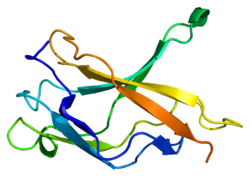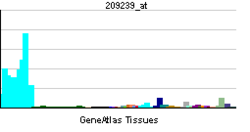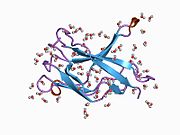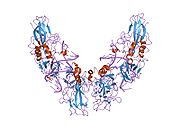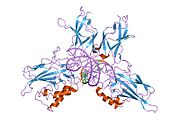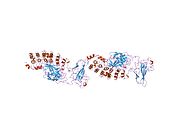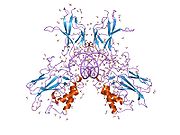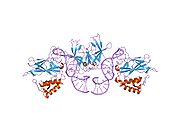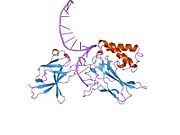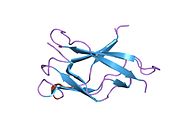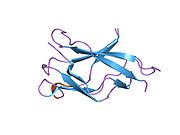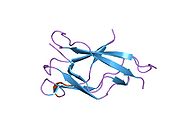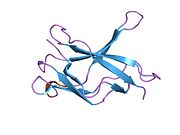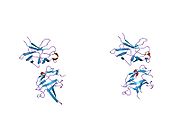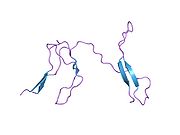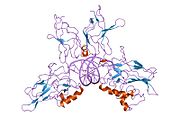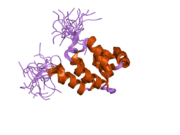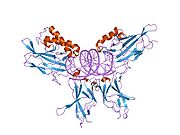- NFKB1
-
Nuclear factor NF-kappa-B p105 subunit is a protein that in humans is encoded by the NFKB1 gene.[1]
This gene encodes a 105 kD protein which can undergo cotranslational processing by the 26S proteasome to produce a 50 kD protein. The 105 kD protein is a Rel protein-specific transcription inhibitor and the 50 kD protein is a DNA binding subunit of the NF-kappaB (NF-κB) protein complex. NF-κB is a transcription factor that is activated by various intra- and extra-cellular stimuli such as cytokines, oxidant-free radicals, ultraviolet irradiation, and bacterial or viral products. Activated NF-κB translocates into the nucleus and stimulates the expression of genes involved in a wide variety of biological functions; over 200 known genes are targets of NF-κB in various cell types, under specific conditions. Inappropriate activation of NF-κB has been associated with a number of inflammatory diseases while persistent inhibition of NF-κB leads to inappropriate immune cell development or delayed cell growth.[2]
Contents
Interactions
NFKB1 has been shown to interact with NFKBIE,[3] IKK2,[4][5] MAP3K7IP2,[6] STAT6,[7] ITGB3BP,[8] IκBα,[9][10] NFKB2,[11] RELA,[11][12] RELB,[11] TSC22D3,[13] NOTCH1,[14][15] HDAC1,[16] LYL1,[17] BCL3,[5][18][19] STAT3,[20] MAP3K8,[11][21] MEN1,[22] Nuclear receptor coactivator 1[23][24] and HMGA2.[25]
References
- ^ Meyer R, Hatada EN, Hohmann HP, Haiker M, Bartsch C, Rothlisberger U, Lahm HW, Schlaeger EJ, van Loon AP, Scheidereit C (Mar 1991). "Cloning of the DNA-binding subunit of human nuclear factor kappa B: the level of its mRNA is strongly regulated by phorbol ester or tumor necrosis factor alpha". Proc Natl Acad Sci U S A 88 (3): 966–70. doi:10.1073/pnas.88.3.966. PMC 50935. PMID 1992489. http://www.pubmedcentral.nih.gov/articlerender.fcgi?tool=pmcentrez&artid=50935.
- ^ "Entrez Gene: NF-κB nuclear factor of kappa light polypeptide gene enhancer in B-cells 1 (p105)". http://www.ncbi.nlm.nih.gov/sites/entrez?Db=gene&Cmd=ShowDetailView&TermToSearch=4790.
- ^ Li, Z; Nabel G J (Oct. 1997). "A new member of the I kappaB protein family, I kappaB epsilon, inhibits RelA (p65)-mediated NF-kappaB transcription". Mol. Cell. Biol. (UNITED STATES) 17 (10): 6184–90. ISSN 0270-7306. PMC 232469. PMID 9315679. http://www.pubmedcentral.nih.gov/articlerender.fcgi?tool=pmcentrez&artid=232469.
- ^ Heissmeyer, V; Krappmann D, Hatada E N, Scheidereit C (Feb. 2001). "Shared pathways of IkappaB kinase-induced SCF(betaTrCP)-mediated ubiquitination and degradation for the NF-kappaB precursor p105 and IkappaBalpha". Mol. Cell. Biol. (United States) 21 (4): 1024–35. doi:10.1128/MCB.21.4.1024-1035.2001. ISSN 0270-7306. PMC 99557. PMID 11158290. http://www.pubmedcentral.nih.gov/articlerender.fcgi?tool=pmcentrez&artid=99557.
- ^ a b Heissmeyer, V; Krappmann D, Wulczyn F G, Scheidereit C (Sep. 1999). "NF-kappaB p105 is a target of IkappaB kinases and controls signal induction of Bcl-3-p50 complexes". EMBO J. (ENGLAND) 18 (17): 4766–78. doi:10.1093/emboj/18.17.4766. ISSN 0261-4189. PMC 1171549. PMID 10469655. http://www.pubmedcentral.nih.gov/articlerender.fcgi?tool=pmcentrez&artid=1171549.
- ^ Baek, Sung Hee; Ohgi Kenneth A, Rose David W, Koo Edward H, Glass Christopher K, Rosenfeld Michael G (Jul. 2002). "Exchange of N-CoR corepressor and Tip60 coactivator complexes links gene expression by NF-kappaB and beta-amyloid precursor protein". Cell (United States) 110 (1): 55–67. doi:10.1016/S0092-8674(02)00809-7. ISSN 0092-8674. PMID 12150997.
- ^ Shen, C H; Stavnezer J (Jun. 1998). "Interaction of stat6 and NF-kappaB: direct association and synergistic activation of interleukin-4-induced transcription". Mol. Cell. Biol. (UNITED STATES) 18 (6): 3395–404. ISSN 0270-7306. PMC 108921. PMID 9584180. http://www.pubmedcentral.nih.gov/articlerender.fcgi?tool=pmcentrez&artid=108921.
- ^ Besta, Felicitas; Massberg Steffen, Brand Korbinian, Müller Elke, Page Sharon, Grüner Sabine, Lorenz Michael, Sadoul Karin, Kolanus Waldemar, Lengyel Ernst, Gawaz Meinrad (Oct. 2002). "Role of beta(3)-endonexin in the regulation of NF-kappaB-dependent expression of urokinase-type plasminogen activator receptor". J. Cell. Sci. (England) 115 (Pt 20): 3879–88. doi:10.1242/jcs.00081. ISSN 0021-9533. PMID 12244126.
- ^ Hay, D C; Kemp G D, Dargemont C, Hay R T (May. 2001). "Interaction between hnRNPA1 and IkappaBalpha is required for maximal activation of NF-kappaB-dependent transcription". Mol. Cell. Biol. (United States) 21 (10): 3482–90. doi:10.1128/MCB.21.10.3482-3490.2001. ISSN 0270-7306. PMC 100270. PMID 11313474. http://www.pubmedcentral.nih.gov/articlerender.fcgi?tool=pmcentrez&artid=100270.
- ^ Malek, S; Huxford T, Ghosh G (Sep. 1998). "Ikappa Balpha functions through direct contacts with the nuclear localization signals and the DNA binding sequences of NF-kappaB". J. Biol. Chem. (UNITED STATES) 273 (39): 25427–35. doi:10.1074/jbc.273.39.25427. ISSN 0021-9258. PMID 9738011.
- ^ a b c d Bouwmeester, Tewis; Bauch Angela, Ruffner Heinz, Angrand Pierre-Olivier, Bergamini Giovanna, Croughton Karen, Cruciat Cristina, Eberhard Dirk, Gagneur Julien, Ghidelli Sonja, Hopf Carsten, Huhse Bettina, Mangano Raffaella, Michon Anne-Marie, Schirle Markus, Schlegl Judith, Schwab Markus, Stein Martin A, Bauer Andreas, Casari Georg, Drewes Gerard, Gavin Anne-Claude, Jackson David B, Joberty Gerard, Neubauer Gitte, Rick Jens, Kuster Bernhard, Superti-Furga Giulio (Feb. 2004). "A physical and functional map of the human TNF-alpha/NF-kappa B signal transduction pathway". Nat. Cell Biol. (England) 6 (2): 97–105. doi:10.1038/ncb1086. ISSN 1465-7392. PMID 14743216.
- ^ Palvimo, J J; Reinikainen P, Ikonen T, Kallio P J, Moilanen A, Jänne O A (Sep. 1996). "Mutual transcriptional interference between RelA and androgen receptor". J. Biol. Chem. (UNITED STATES) 271 (39): 24151–6. doi:10.1074/jbc.271.39.24151. ISSN 0021-9258. PMID 8798655.
- ^ Ayroldi, E; Migliorati G, Bruscoli S, Marchetti C, Zollo O, Cannarile L, D'Adamio F, Riccardi C (Aug. 2001). "Modulation of T-cell activation by the glucocorticoid-induced leucine zipper factor via inhibition of nuclear factor kappaB". Blood (United States) 98 (3): 743–53. doi:10.1182/blood.V98.3.743. ISSN 0006-4971. PMID 11468175.
- ^ Guan, E; Wang J, Laborda J, Norcross M, Baeuerle P A, Hoffman T (May. 1996). "T cell leukemia-associated human Notch/translocation-associated Notch homologue has I kappa B-like activity and physically interacts with nuclear factor-kappa B proteins in T cells". J. Exp. Med. (UNITED STATES) 183 (5): 2025–32. doi:10.1084/jem.183.5.2025. ISSN 0022-1007. PMC 2192574. PMID 8642313. http://www.pubmedcentral.nih.gov/articlerender.fcgi?tool=pmcentrez&artid=2192574.
- ^ Wang, J; Shelly L, Miele L, Boykins R, Norcross M A, Guan E (Jul. 2001). "Human Notch-1 inhibits NF-kappa B activity in the nucleus through a direct interaction involving a novel domain". J. Immunol. (United States) 167 (1): 289–95. ISSN 0022-1767. PMID 11418662.
- ^ Zhong, Haihong; May Michael J, Jimi Eijiro, Ghosh Sankar (Mar. 2002). "The phosphorylation status of nuclear NF-kappa B determines its association with CBP/p300 or HDAC-1". Mol. Cell (United States) 9 (3): 625–36. doi:10.1016/S1097-2765(02)00477-X. ISSN 1097-2765. PMID 11931769.
- ^ Ferrier, R; Nougarede R, Doucet S, Kahn-Perles B, Imbert J, Mathieu-Mahul D (Jan. 1999). "Physical interaction of the bHLH LYL1 protein and NF-kappaB1 p105". Oncogene (ENGLAND) 18 (4): 995–1005. doi:10.1038/sj.onc.1202374. ISSN 0950-9232. PMID 10023675.
- ^ Thornburg, Natalie J; Pathmanathan Rajadurai, Raab-Traub Nancy (Dec. 2003). "Activation of nuclear factor-kappaB p50 homodimer/Bcl-3 complexes in nasopharyngeal carcinoma". Cancer Res. (United States) 63 (23): 8293–301. ISSN 0008-5472. PMID 14678988.
- ^ Naumann, M; Wulczyn F G, Scheidereit C (Jan. 1993). "The NF-kappa B precursor p105 and the proto-oncogene product Bcl-3 are I kappa B molecules and control nuclear translocation of NF-kappa B". EMBO J. (ENGLAND) 12 (1): 213–22. ISSN 0261-4189. PMC 413194. PMID 8428580. http://www.pubmedcentral.nih.gov/articlerender.fcgi?tool=pmcentrez&artid=413194.
- ^ Yu, Zhiyuan; Zhang Wenzheng, Kone Bruce C (Oct. 2002). "Signal transducers and activators of transcription 3 (STAT3) inhibits transcription of the inducible nitric oxide synthase gene by interacting with nuclear factor kappaB". Biochem. J. (England) 367 (Pt 1): 97–105. doi:10.1042/BJ20020588. ISSN 0264-6021. PMC 1222853. PMID 12057007. http://www.pubmedcentral.nih.gov/articlerender.fcgi?tool=pmcentrez&artid=1222853.
- ^ Belich, M P; Salmerón A, Johnston L H, Ley S C (Jan. 1999). "TPL-2 kinase regulates the proteolysis of the NF-kappaB-inhibitory protein NF-kappaB1 p105". Nature (ENGLAND) 397 (6717): 363–8. doi:10.1038/16946. ISSN 0028-0836. PMID 9950430.
- ^ Heppner, C; Bilimoria K Y, Agarwal S K, Kester M, Whitty L J, Guru S C, Chandrasekharappa S C, Collins F S, Spiegel A M, Marx S J, Burns A L (Aug. 2001). "The tumor suppressor protein menin interacts with NF-kappaB proteins and inhibits NF-kappaB-mediated transactivation". Oncogene (England) 20 (36): 4917–25. doi:10.1038/sj.onc.1204529. ISSN 0950-9232. PMID 11526476.
- ^ Lee, S K; Na S Y, Jung S Y, Choi J E, Jhun B H, Cheong J, Meltzer P S, Lee Y C, Lee J W (Jun. 2000). "Activating protein-1, nuclear factor-kappaB, and serum response factor as novel target molecules of the cancer-amplified transcription coactivator ASC-2". Mol. Endocrinol. (UNITED STATES) 14 (6): 915–25. doi:10.1210/me.14.6.915. ISSN 0888-8809. PMID 10847592.
- ^ Na, S Y; Lee S K, Han S J, Choi H S, Im S Y, Lee J W (May. 1998). "Steroid receptor coactivator-1 interacts with the p50 subunit and coactivates nuclear factor kappaB-mediated transactivations". J. Biol. Chem. (UNITED STATES) 273 (18): 10831–4. doi:10.1074/jbc.273.18.10831. ISSN 0021-9258. PMID 9556555.
- ^ Noro, Barbara; Licheri Barbara, Sgarra Riccardo, Rustighi Alessandra, Tessari Michela A, Chau Kai-Yin, Ono Santa Jeremy, Giancotti Vincenzo, Manfioletti Guidalberto (Apr. 2003). "Molecular dissection of the architectural transcription factor HMGA2". Biochemistry (United States) 42 (15): 4569–77. doi:10.1021/bi026605k. ISSN 0006-2960. PMID 12693954.
- This article incorporates text from the United States National Library of Medicine, which is in the public domain.
PDB gallery 1bfs: STRUCTURE OF NF-KB P50 HOMODIMER BOUND TO A KB SITE1ikn: IKAPPABALPHA/NF-KAPPAB COMPLEX1le5: Crystal structure of a NF-kB heterodimer bound to an IFNb-kB1le9: Crystal structure of a NF-kB heterodimer bound to the Ig/HIV-kB siti1lei: The kB DNA sequence from the HLV-LTR functions as an allosteric regulator of HIV transcription1nfi: I-KAPPA-B-ALPHA/NF-KAPPA-B COMPLEX1nfk: STRUCTURE OF THE NUCLEAR FACTOR KAPPA-B (NF-KB) P50 HOMODIMER1ooa: CRYSTAL STRUCTURE OF NF-kB(p50)2 COMPLEXED TO A HIGH-AFFINITY RNA APTAMER1svc: NFKB P50 HOMODIMER BOUND TO DNA1u36: Crystal structure of WLAC mutant of dimerisation domain of NF-kB p50 transcription factor1u3j: Crystal structure of MLAV mutant of dimerisation domain of NF-kB p50 transcription factor1u3y: Crystal structure of ILAC mutant of dimerisation domain of NF-kB p50 transcription factor1u3z: Crystal structure of MLAC mutant of dimerisation domain of NF-kB p50 transcription factor1u41: Crystal structure of YLGV mutant of dimerisation domain of NF-kB p50 transcription factor1u42: Crystal structure of MLAM mutant of dimerisation domain of NF-kB p50 transcription factor1vkx: CRYSTAL STRUCTURE OF THE NFKB P50/P65 HETERODIMER COMPLEXED TO THE IMMUNOGLOBULIN KB DNA2dbf: Solution structure of the Death domain in human Nuclear factor NF-kappa-B p105 subunit2i9t: Structure of NF-kB p65-p50 heterodimer bound to PRDII element of B-interferon promoterFurther reading
- Baldwin AS (1996). "The NF-kappa B and I kappa B proteins: new discoveries and insights.". Annu. Rev. Immunol. 14: 649–83. doi:10.1146/annurev.immunol.14.1.649. PMID 8717528.
- Snásel J, Pichová I (1997). "The cleavage of host cell proteins by HIV-1 protease.". Folia Biol. (Praha) 42 (5): 227–30. doi:10.1007/BF02818986. PMID 8997639.
- Chen F, Castranova V, Shi X, Demers LM (1999). "New insights into the role of nuclear factor-kappaB, a ubiquitous transcription factor in the initiation of diseases.". Clin. Chem. 45 (1): 7–17. PMID 9895331.
- Bottex-Gauthier C, Pollet S, Favier A, Vidal DR (2002). "[The Rel/NF-kappa-B transcription factors: complex role in cell regulation]". Pathol. Biol. 50 (3): 204–11. PMID 11980335.
- Garg A, Aggarwal BB (2002). "Nuclear transcription factor-kappaB as a target for cancer drug development.". Leukemia 16 (6): 1053–68. doi:10.1038/sj.leu.2402482. PMID 12040437.
- Sun Z, Andersson R (2003). "NF-kappaB activation and inhibition: a review.". Shock 18 (2): 99–106. doi:10.1097/00024382-200208000-00001. PMID 12166787.
- Mercurio AM (2003). "Invasive skin carcinoma--Ras and alpha6beta4 integrin lead the way.". Cancer Cell 3 (3): 201–2. doi:10.1016/S1535-6108(03)00049-7. PMID 12676577.
- Sun SC, Xiao G (2004). "Deregulation of NF-kappaB and its upstream kinases in cancer.". Cancer Metastasis Rev. 22 (4): 405–22. doi:10.1023/A:1023733231406. PMID 12884915.
- Kucharczak J, Simmons MJ, Fan Y, Gélinas C (2004). "To be, or not to be: NF-kappaB is the answer--role of Rel/NF-kappaB in the regulation of apoptosis.". Oncogene 22 (56): 8961–82. doi:10.1038/sj.onc.1207230. PMID 14663476.
- Suh J, Rabson AB (2004). "NF-kappaB activation in human prostate cancer: important mediator or epiphenomenon?". J. Cell. Biochem. 91 (1): 100–17. doi:10.1002/jcb.10729. PMID 14689584.
- Muthumani K, Desai BM, Hwang DS, et al. (2004). "HIV-1 Vpr and anti-inflammatory activity.". DNA Cell Biol. 23 (4): 239–47. doi:10.1089/104454904773819824. PMID 15142381.
- Schmitz ML, Mattioli I, Buss H, Kracht M (2005). "NF-kappaB: a multifaceted transcription factor regulated at several levels.". Chembiochem 5 (10): 1348–58. doi:10.1002/cbic.200400144. PMID 15457532.
- Pise-Masison CA, Brady JN (2006). "Setting the stage for transformation: HTLV-1 Tax inhibition of p53 function.". Front. Biosci. 10: 919–30. doi:10.2741/1586. PMID 15569630.
- Joseph AM, Kumar M, Mitra D (2005). "Nef: "necessary and enforcing factor" in HIV infection.". Curr. HIV Res. 3 (1): 87–94. doi:10.2174/1570162052773013. PMID 15638726.
- Le Rouzic E, Benichou S (2006). "The Vpr protein from HIV-1: distinct roles along the viral life cycle.". Retrovirology 2: 11. doi:10.1186/1742-4690-2-11. PMC 554975. PMID 15725353. http://www.pubmedcentral.nih.gov/articlerender.fcgi?tool=pmcentrez&artid=554975.
- Zhao RY, Elder RT (2005). "Viral infections and cell cycle G2/M regulation.". Cell Res. 15 (3): 143–9. doi:10.1038/sj.cr.7290279. PMID 15780175.
- Zhao RY, Bukrinsky M, Elder RT (2005). "HIV-1 viral protein R (Vpr) & host cellular responses.". Indian J. Med. Res. 121 (4): 270–86. PMID 15817944.
- Muthumani K, Choo AY, Hwang DS, et al. (2006). "HIV-1 Vpr: enhancing sensitivity of tumors to apoptosis.". Current drug delivery 1 (4): 335–44. doi:10.2174/1567201043334614. PMID 16305395.
- Courtois G, Smahi A (2006). "NF-kappaB-related genetic diseases.". Cell Death Differ. 13 (5): 843–51. doi:10.1038/sj.cdd.4401841. PMID 16397577.
- Mattson MP, Meffert MK (2006). "Roles for NF-kappaB in nerve cell survival, plasticity, and disease.". Cell Death Differ. 13 (5): 852–60. doi:10.1038/sj.cdd.4401837. PMID 16397579.
- Schmitz ML, Krappmann D (2006). "Controlling NF-kappaB activation in T cells by costimulatory receptors.". Cell Death Differ. 13 (5): 834–42. doi:10.1038/sj.cdd.4401845. PMID 16410801.
- Janssens S, Tschopp J (2006). "Signals from within: the DNA-damage-induced NF-kappaB response.". Cell Death Differ. 13 (5): 773–84. doi:10.1038/sj.cdd.4401843. PMID 16410802.
- Perkins ND, Gilmore TD (2006). "Good cop, bad cop: the different faces of NF-kappaB.". Cell Death Differ. 13 (5): 759–72. doi:10.1038/sj.cdd.4401838. PMID 16410803.
- Weil R, Israël A (2006). "Deciphering the pathway from the TCR to NF-kappaB.". Cell Death Differ. 13 (5): 826–33. doi:10.1038/sj.cdd.4401856. PMID 16439988.
- Kim HJ, Hawke N, Baldwin AS (2006). "NF-kappaB and IKK as therapeutic targets in cancer.". Cell Death Differ. 13 (5): 738–47. doi:10.1038/sj.cdd.4401877. PMID 16485028.
- Braun T, Carvalho G, Fabre C, et al. (2006). "Targeting NF-kappaB in hematologic malignancies.". Cell Death Differ. 13 (5): 748–58. doi:10.1038/sj.cdd.4401874. PMID 16498458.
- Bottero V, Withoff S, Verma IM (2006). "NF-kappaB and the regulation of hematopoiesis.". Cell Death Differ. 13 (5): 785–97. doi:10.1038/sj.cdd.4401888. PMID 16528384.
- Xiao G (2007). "Autophagy and NF-kappaB: fight for fate.". Cytokine Growth Factor Rev. 18 (3-4): 233–43. doi:10.1016/j.cytogfr.2007.04.006. PMC 2810660. PMID 17485237. http://www.pubmedcentral.nih.gov/articlerender.fcgi?tool=pmcentrez&artid=2810660.
External links
Transcription factors and intracellular receptors (1) Basic domains (1.1) Basic leucine zipper (bZIP)Activating transcription factor (AATF, 1, 2, 3, 4, 5, 6, 7) · AP-1 (c-Fos, FOSB, FOSL1, FOSL2, JDP2, c-Jun, JUNB, JUND) · BACH (1, 2) · BATF · BLZF1 · C/EBP (α, β, γ, δ, ε, ζ) · CREB (1, 3, L1) · CREM · DBP · DDIT3 · GABPA · HLF · MAF (B, F, G, K) · NFE (2, L1, L2, L3) · NFIL3 · NRL · NRF (1, 2, 3) · XBP1(1.2) Basic helix-loop-helix (bHLH)ATOH1 · AhR · AHRR · ARNT · ASCL1 · BHLHB2 · BMAL (ARNTL, ARNTL2) · CLOCK · EPAS1 · FIGLA · HAND (1, 2) · HES (5, 6) · HEY (1, 2, L) · HES1 · HIF (1A, 3A) · ID (1, 2, 3, 4) · LYL1 · MESP2 · MXD4 · MYCL1 · MYCN · Myogenic regulatory factors (MyoD, Myogenin, MYF5, MYF6) · Neurogenins (1, 2, 3) · NeuroD (1, 2) · NPAS (1, 2, 3) · OLIG (1, 2) · Pho4 · Scleraxis · SIM (1, 2) · TAL (1, 2) · Twist · USF1(1.3) bHLH-ZIP(1.4) NF-1(1.5) RF-X(1.6) Basic helix-span-helix (bHSH)(2) Zinc finger DNA-binding domains (2.1) Nuclear receptor (Cys4)subfamily 1 (Thyroid hormone (α, β), CAR, FXR, LXR (α, β), PPAR (α, β/δ, γ), PXR, RAR (α, β, γ), ROR (α, β, γ), Rev-ErbA (α, β), VDR)
subfamily 2 (COUP-TF (I, II), Ear-2, HNF4 (α, γ), PNR, RXR (α, β, γ), Testicular receptor (2, 4), TLX)
subfamily 3 (Steroid hormone (Androgen, Estrogen (α, β), Glucocorticoid, Mineralocorticoid, Progesterone), Estrogen related (α, β, γ))
subfamily 4 NUR (NGFIB, NOR1, NURR1) · subfamily 5 (LRH-1, SF1) · subfamily 6 (GCNF) · subfamily 0 (DAX1, SHP)(2.2) Other Cys4(2.3) Cys2His2General transcription factors (TFIIA, TFIIB, TFIID, TFIIE (1, 2), TFIIF (1, 2), TFIIH (1, 2, 4, 2I, 3A, 3C1, 3C2))
ATBF1 · BCL (6, 11A, 11B) · CTCF · E4F1 · EGR (1, 2, 3, 4) · ERV3 · GFI1 · GLI-Krüppel family (1, 2, 3, REST, S2, YY1) · HIC (1, 2) · HIVEP (1, 2, 3) · IKZF (1, 2, 3) · ILF (2, 3) · KLF (2, 3, 4, 5, 6, 7, 8, 9, 10, 11, 12, 13, 14, 15, 17) · MTF1 · MYT1 · OSR1 · PRDM9 · SALL (1, 2, 3, 4) · SP (1, 2, 4, 7, 8) · TSHZ3 · WT1 · Zbtb7 (7A, 7B) · ZBTB (16, 17, 20, 32, 33, 40) · zinc finger (3, 7, 9, 10, 19, 22, 24, 33B, 34, 35, 41, 43, 44, 51, 74, 143, 146, 148, 165, 202, 217, 219, 238, 239, 259, 267, 268, 281, 295, 300, 318, 330, 346, 350, 365, 366, 384, 423, 451, 452, 471, 593, 638, 644, 649, 655)(2.4) Cys6(2.5) Alternating composition(3) Helix-turn-helix domains (3.1) HomeodomainARX · CDX (1, 2) · CRX · CUTL1 · DBX (1, 2) · DLX (3, 4, 5) · EMX2 · EN (1, 2) · FHL (1, 2, 3) · HESX1 · HHEX · HLX · Homeobox (A1, A2, A3, A4, A5, A7, A9, A10, A11, A13, B1, B2, B3, B4, B5, B6, B7, B8, B9, B13, C4, C5, C6, C8, C9, C10, C11, C13, D1, D3, D4, D8, D9, D10, D11, D12, D13) · HOPX · IRX (1, 2, 3, 4, 5, 6, MKX) · LMX (1A, 1B) · MEIS (1, 2) · MEOX2 · MNX1 · MSX (1, 2) · NANOG · NKX (2-1, 2-2, 2-3, 2-5, 3-1, 3-2, 6-1, 6-2) · NOBOX · PBX (1, 2, 3) · PHF (1, 3, 6, 8, 10, 16, 17, 20, 21A) · PHOX (2A, 2B) · PITX (1, 2, 3) · POU domain (PIT-1, BRN-3: A, B, C, Octamer transcription factor: 1, 2, 3/4, 6, 7, 11) · OTX (1, 2) · PDX1 · SATB2 · SHOX2 · VAX1 · ZEB (1, 2)(3.2) Paired box(3.3) Fork head / winged helix(3.4) Heat Shock Factors(3.5) Tryptophan clusters(3.6) TEA domain(4) β-Scaffold factors with minor groove contacts (4.1) Rel homology region(4.2) STAT(4.3) p53(4.4) MADS box(4.6) TATA binding proteins(4.7) High-mobility group(4.10) Cold-shock domainCSDA, YBX1(4.11) Runt(0) Other transcription factors (0.2) HMGI(Y)(0.3) Pocket domain(0.6) Miscellaneoussee also transcription factor/coregulator deficiencies
B bsyn: dna (repl, cycl, reco, repr) · tscr (fact, tcrg, nucl, rnat, rept, ptts) · tltn (risu, pttl, nexn) · dnab, rnab/runp · stru (domn, 1°, 2°, 3°, 4°)Categories:- Human proteins
- Transcription factors
Wikimedia Foundation. 2010.

